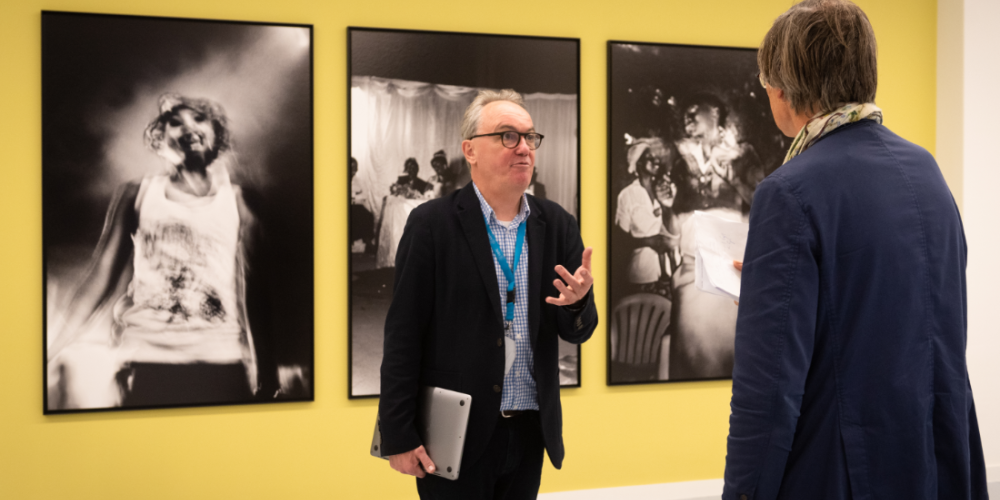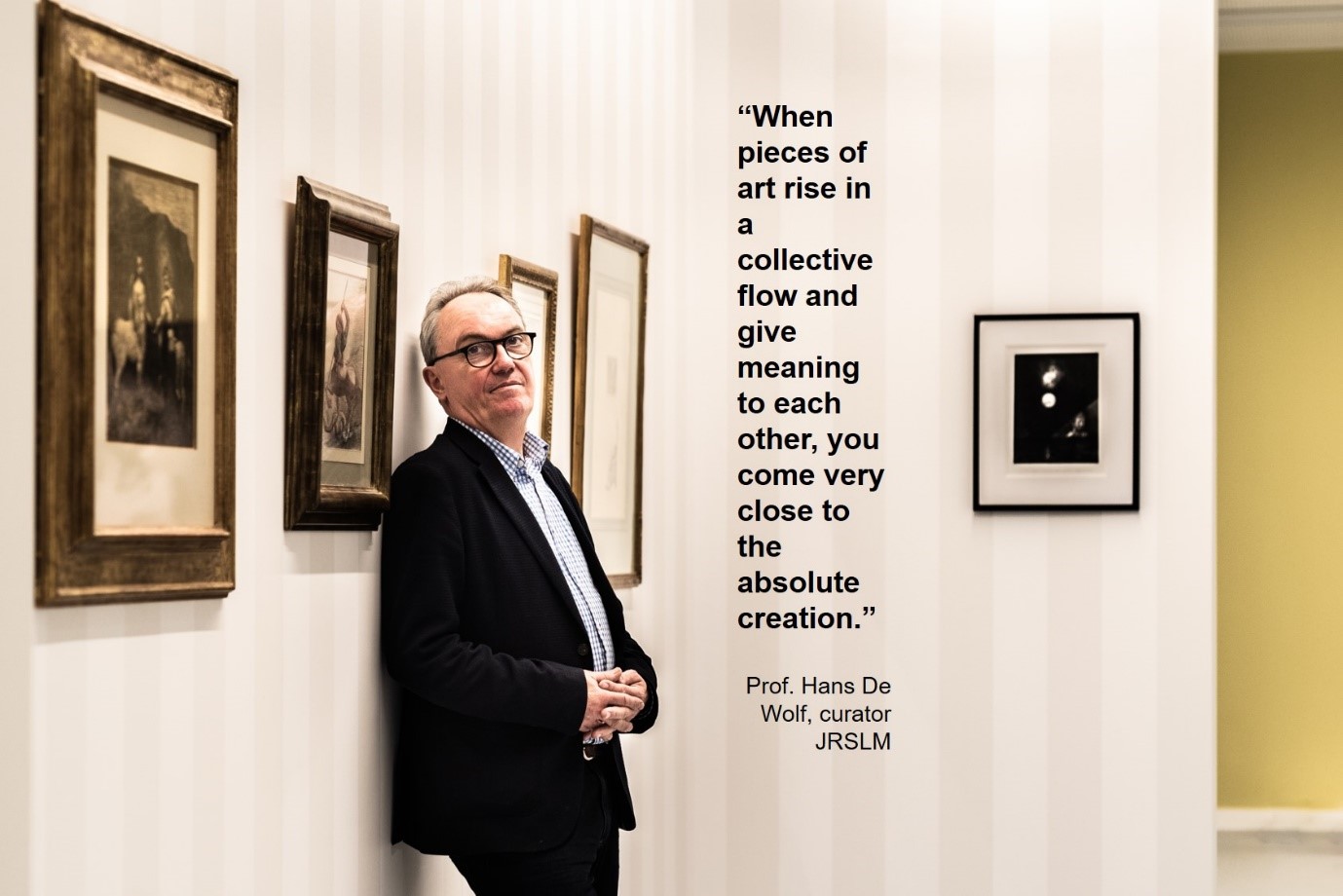
At Pilar, the new cultural hot spot of the Vrije Universiteit Brussel, you can still visit the exhibition JRSLM until 14 December. We talked to Hans De Wolf, professor in Art History and curator, who, for the occasion, brought top artwork never shown before to the VUB.
Text: Katrien Elen. Photos: Thierry Geenen
The curating professor
Where can we find another ladder and what colour should we paint that wall? With the same amount of flair, Prof De Wolf guides us along the artwork, while making the final practical decisions a couple of days before the vernissage. Fortunately, the enraptured professor is very hands-on. As a curator, he has years of international experience, from Berlin to Beijing: “The academic world was a late calling, but the two worlds turned out to be perfectly complementary. My intense contacts with artists enrich my thinking as a professor. I believe that makes sense. You wouldn’t want to be operated on by a professor who has never opened up a body either.”
My intense contacts with artists enrich my thinking as a professor.
Spirituality at a free university
The idea for the exhibition was formed one year ago during conversations with rector Caroline Pauwels. The duo were on the same wavelength immediately: “When you turn fifty, you have to ask yourself: who am I and where do I come from?” Prof De Wolf noticed two connecting threads right away: “The VUB was formed in a liberal environment in which there was no place left for religion. Still, to this day, religion is very present and often a source of conflict. The second connecting thread is the inadequacy of reason. Even if you collected all knowledge at the university, it would still be insufficient to achieve true freedom. For that, apparently, we still need forms of spirituality, even at the university.”
To achieve true freedom, apparently, we still need forms of spirituality, even at the university.
So, JRSLM is not just a festive exhibition with reference to 50 years of VUB, as Prof De Wolf’s message is quite sharp. “That’s right,” he says, “an academic has to be critical. I find that many scientists have let go of the necessary connection with the mystical. From an agnostic tradition, they have become hardened. However, we must dare to let the mystical in again. Anything should be debatable at the VUB, that was our founding fathers’ conviction. That’s why I hope that in the exhibition’s bright room – where intelligence and mysticism go hand in hand - my colleagues will reflect on the question: am I doing a good job?”
Continue reading underneath the image.

But why the reference to Jerusalem in the exhibition’s title, if this isn’t a religious exhibition? Prof De Wolf: “Jerusalem is a city that has given hope to billions of people, but as soon as you arrive there, you experience the complete absurdity of religion. To me, the city embodies the contradiction this exhibition is about: the hope for paradise, via reason (cf ‘being free’ ed), and the failure. That’s why the subtitle is Paradise lost again.”
Jerusalem embodies the contradiction this exhibition is about: the hope for paradise – and the failure.
Artwork never shown before
While we are making our way through the exhibition, what’s striking is that the artwork is world class. Some pieces like those of Michaël Borremans and Dirk Braeckman have never even been exhibited in Europe before. Francis Alÿs’s When faith moves mountains, a film in which volunteers move a sand dune, is one of the five most in-demand works of art in the world. However did the curator manage to bring together those pieces? De Wolf: “Most museums have top artwork on loan via an exchange deal, but the VUB obviously doesn’t have any art to loan. As a curator, you then really have to depend on the story you want to tell. With a coherent narrative, you can win over artists. JRSLM’s plan is very topical, which is why artists have made great concessions. For example, I asked Michaël Borremans for a small piece, but he proposed to ask for one of his monumental pieces from a private collection. That’s brilliant, of course.”
Most museums have top artwork on loan via an exchange deal, but the VUB obviously doesn’t have any art to loan. As a curator, you then really have to depend on the story you want to tell.
Working together after 50 years of separation
Organizing an exhibition is not something you can do on your own. Prof De Wolf gathered a small team; students offered to help voluntarily and companies were charmed by the project as well. But the most notable collaboration is the one with the ULB. “It’s almost moving how smoothly that went,” says Prof De Wolf. “Not only did they provide us with display cases, for example, but they will also paint one of the works of art, the Dymaxion map by Fuller, on the outside walls of Flagey, a building with the ULB’s signature.
Curating as a form of art
As we arrive at the end of the exhibition and Prof De Wolf, in between his passionate talks, has found the solution to a missing sheet of glass and a ringing alarm, it becomes clear that he is a man with a calling. The curator can only agree with that: “In the build-up to an exhibition, you encounter a lot of mission impossibles, but there is nothing more rewarding than bringing together works of art. When pieces of art rise in a collective flow and give meaning to each other, you come very close to the absolute creation.”
Practical information? JRSLM, from 17 October to 12 December, Brussels Humanities Science and Engineering campus in Etterbeek, Brussels Health Campus in Jette and Usquare, from Tuesday to Saturday, from 12:00 – 18:00. Free access. www.vub.be/JRSLM
